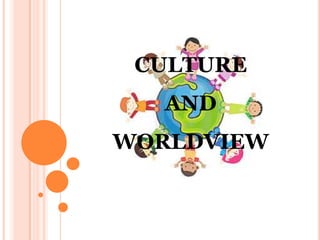
ELECTIVE 1 (Culture and Worldview)
- 2. CULTURE The label anthropologists give to the structured customs and underlying worldview assumptions which people govern their lives. Culture is a peoples’ way of life, their design for living, their way of coping with their biological, physical, and social environment. It consists of learned, patterned assumptions (worldview), concepts and behavior, plus the resulting artifacts (material culture).
- 3. WORLDVIEW The deep level of culture, is the culturally structured set of assumptions including values and commitments/allegiances underlying how people perceive and respond to reality.
- 4. CHARACTERISTICS OF CULTURE AND WORLDVIEW Culture/Worldview provides a total design for living, dealing with every aspect of life and providing people with a way to regulate their lives. Culture/Worldview is a legacy from the past, learned as if it were absolute and perfect. Culture/Worldview makes sense to those within it.
- 5. But no culture/worldview seems to be perfectly adequate either to the realities of biology and environment or the answering questions of people. Culture/Worldview is an adaptive system, a mechanism for coping. It provides patterns and strategies to enable people adapt to the physical and social conditions around them.
- 6. Culture tends to show more or less tight integration around its worldview. Worldview assumptions provide the “glue” with which people hold their culture together. Culture/Worldview is complex. No simple culture/worldview has ever been found. Cultural/Worldview practices and assumptions are based on group or multicultural agreements.
- 7. Culture/Worldview is structural. It doesn’t do anything. Though analytically we need to treat people and culture/worldview as separate entities, in real life people and culture/worldview function together.
- 8. THE SUBSYSTEMS OF CULTURE Social subsystem Religion subsystem WORLDVIEW Economics subsystem Language subsystem
- 9. CULTURE AND EXPERIENCE We all develop expectations based on our early experiences. Some are biological, such as food, comforts or pain. But expectations are also greatly affected by all kinds of experiences. We formulate expectations from previous experiences, guided by the society around us and by our own analytical faculties. We learn from experience, but then we process and evaluate new experiences in light of our previous experiences.
- 10. SHARED EXPERIENCES As a group of people go through certain experiences together, they develop a certain bond of empathy and identification. As they reflect on the meaning of these life experiences and adapt to the circumstances, they further come to have a similar perspective on their situation. This reflection and their response to the circumstances normally lead to a generalization of what the world must be like. A culture group also usually shares a common language, which is a strong identifying and unifying factor, both as an expression of the common perspective and as a factor in the development or change of that common perspective. Language is one of the significant experiences of a community.
- 11. AN EARLY-EXPERIENCE MODEL We see this when children learn language. They listen, then they begin making noises. They continue listening and analyzing, and before long they are generating their own sentences which they have not heard before. They use this early-experience model to understand the new experience. This basic model goes for all areas of life and learning. Previous learning and experience become the format for later learning and experience. We can say that culture is based on shared significant experiences. Each society has a collection (formal or informal) of social institutions and practices correlating and expressing a common perspective of a group of people sharing an identifiable set of common or shared experiences.
- 12. INSTITUTIONS These shared experiences and common identifying features lead to a somewhat common perspective on reality, moral and social values and assumptions which are entailed in the common social "institutions." The more similar the unique sets of experiences of two individuals or two societies, the more similar their view of reality will normally be. We often use the term worldview for the shared perspective of such a culture group, or the set of assumptions arising from their shared significant experiences. This set of shared experiences, leading to a shared worldview, gives identity to the members and draws the line that separates insiders and outsiders.
- 13. OUTSIDERS The outsider entering the society or culture must learn and assimilate the major features of the worldview, that is, to take on the identity of the insider, in order to communicate and gain acceptance (credibility) with insiders. Foreigners who do not may be regarded with suspicion and mistrusted or resented, particularly if they suggest making changes in aspects of the society, like religion, political structure or certain social practices or institutions. This process of learning and assimilating (or appreciating) the worldview includes language learning, a more obvious characteristic of the society. The language provides a vehicle for the worldview. The way the language works reflects the philosophy and worldview of the society. It appears that worldview affects language, and language affects worldview.
- 14. SHARING TO UNDERSTAND To adequately understand and appreciate the worldview, a foreigner needs to experience the most important of those shared experiences. The outsider has not shared the same set of experiences the insiders have. In order to communicate effectively, to operate from within the society or culture, the outsider needs to share at least the most significant of these experiences with the host culture, so that the outsider's worldview will grow to entail more of the insider's worldview.
- 15. THANKS FOR VIEWING OUR PRESENTATION!
- 16. GROUP 2 Berro, Roy Francis A. Chua, Debilyn Mae T. San Juan, Jellien D. Tumala, Ellenoi S. Jabon, Marjelit Joy R. Manlangit, Erna B. Nabos, Gyselle P. Submitted to: MR. MARK LLANTO Instructor in Elective
